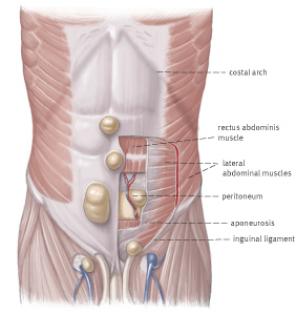1.2.1 The abdominal wall
The anterior abdominal wall is bordered at the upper end by the rib cage and at the lower end by the inguinal ligament. It is composed of different layers of tissue lying on top of each other and enclosed on the outside by the skin. Situated immediately beneath the skin is fat tissue (subcutaneous adipose tissue), beneath that various muscle layers with associated tendon plates (also called "aponeuroses"). The abdominal wall musculature includes the three lateral abdominal muscles which, with their wide and flattened tendons providing elastic support, like a corset, to the abdominal contents. There is also the anterior rectus abdominis muscle (rectus muscle) running down the midline of the body and containing a tendinous cover called the rectus sheath. This, too, is closely intertwined with connective tissue structures of the abdominal wall and helps retain the abdominal contents in position. Beneath the muscle layers is, in addition to connective and adipose tissue, the peritoneum. It serves as a smooth lining covering the abdominal cavity and enclosing the majority of internal organs. [Fig. 1]

Fig 1: The anatomy of the abdominal wall
